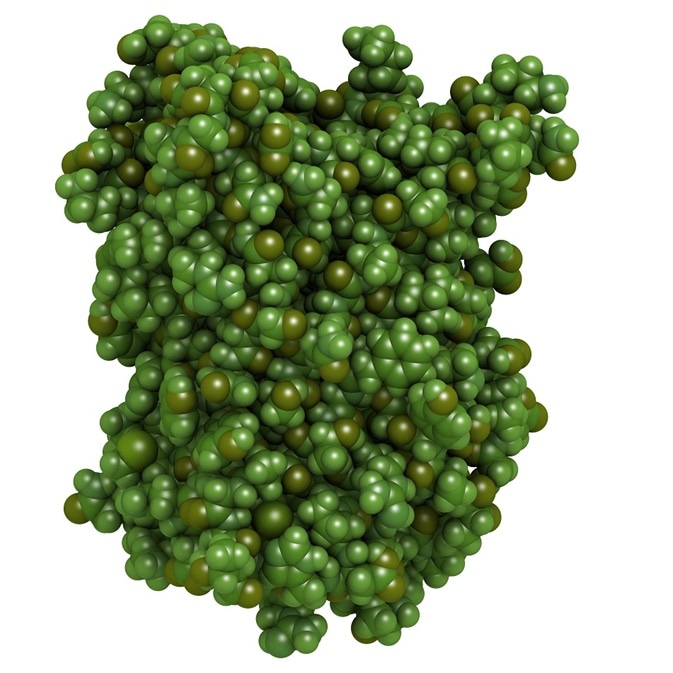Green fluorescent protein (GFP) is a bioluminescent polypeptide protein that is extracted from jellyfish (Aequorea victoria). A protein, known as aequorin, in Aequorea Victoria exposes blue light when it binds with calcium. GFP completely absorbs this blue light and emits it as a green light.

Credit: molekuul_be/ Shutterstock.com
Some GFP variants are used as non-invasive intracellular pH biosensors or fluorescent indicators for local Ca2+ concentrations. Recently, the utility of this technology has been enhanced by the development of GFP variants with altered fluorescence spectra.
These differently colored GFPs might in future prove to be very useful for marking distinct protein populations or cellular organelles for double- or multiple-labeling experiments. Although a blue-shifted variant of GFP (BFP) can be spectrally resolved from GFP, it has a low quantum yield and is not photostable, which limits its usefulness. On contrary, recently generated mutants of GFP with yellow-shifted (YFP) and cyan-shifted (CFP) emission spectrum are highly stable and brighter, when compared to BFP.
Cyan Aequorea fluorescent proteins (CFP)
Cyan (CFP) color variants that are extracted from the Aequorea GFP are considered to be a perfect alternative to BFPs. Cyan fluorescence exists as a result of substitution of Tyr66 with tryptophan. An enhanced version of cyan fluorescence protein has been generated by adding several substitutions inside the structure of surrounding β-barrel.
In addition, the complex enhanced cyan fluorescent protein (ECFP) excitation spectrum states that the number of excited state species for ECFP is always greater than one, and this has eventually been concluded using measurements of fluorescence lifetime.
Targeted substitutions on the ECFP surface exposed to solvent resulted in high-performance variants (cerulean) in complex ECFP excited state characteristics. The excited state of cerulean is simple compared to ECFP. It has increased quantum yield and high extinction coefficient. Cerulean is considered as the most useful derivative of Aequorea.
Yellowish-green Aequorea fluorescent proteins (YFP)
YFP are Aequorea GFP variants that emit the longest wavelengths and they are generated once when the native GFP crystal structure is inspected. Research conducted using X-rays show that the chromophore lay in close proximity to the residue in β-barrel. In this position, the substitutions had the capability to vary the protein’s spectral profile.
EYFP, the enhanced version of YFP, is the most widely used fluorescent protein. However, the pH sensitivity is very high in acidic conditions, as it loses half of its fluorescence when it undergoes interaction.
Also, EYFP is highly sensitive to the ions of chloride and has poor photo stability property compared with other Aequorea FP variants. However, environmental sensitivity of YFP has been completely utilized by researchers to develop biosensors that are used to measure chloride ion concentrations and cytoplasmic pH.
Different EYFP variants have been introduced that may be useful in many specialized applications. Super yellow fluorescent protein (SYFP) is considerably brighter than parent protein when expressed in mammalian and bacteria cells.
CFP and YFP on GFP
Reporter gene expression in adult stem cells (ASCs) has wide applications in stem cell research. The ability to track adult stem cells when fusing a non-cytotoxic, fluorescent reporter gene into the ASC genome is specifically desired for stem cell transplantation research.
Quick investigations of cell function and protein ion can be achieved using fluorescent proteins. In contrast, the availability of stably expressing cell strains with low expression variability for long-term research is very complex. One of the reasons for this complexity is the cytotoxicity of GFP.
In addition to GFP, YFP and CFP were evaluated to prevent toxicity effects that are specifically caused by GFP while stable marking is attempted on rat hepatic ASC strain. Stable fluorescent clones that express either YFP or CFP were developed while it was difficult to develop stable GFP-expressing strains.
CyPet and YPet
Another EYFP variant was developed by applying revolutionary mutagenesis strategy to cDNAs that encode a linked YFP–CFP pair. The objective of this development of EYFP variant was to mutate YFP and CFP simultaneously and to select pairs that have enhanced FRET efficiency. The cDNA libraries were directly evaluated for FRET efficiency and the best clones were detected.
These clones were subjected to synthetic DNA shuffling and many revolutionary cycles of random mutagenesis. This process had resulted in the development of CyPet–YPet (for yellow or cyan fluorescent protein for energy transfer), which is a new CFP–YFP pair that had shown four-fold enhancement in the ratiometric FRET.
A sum of seven mutations we stacked in CFP when directed evolution is carried out to yield CyPet. These mutations featured maximum emission and absorption at 477 nm and 435 nm, respectively. Nevertheless, CyPet cannot be used for stand-alone applications as its brightness is less than cerulean. In contrast, YPet is the brightest variant compared to all YFP variants and exhibits excellent photo stability.
Additionally, YPet has the highest resistivity in an acidic environment compared to all other YFP derivatives and hence is used in biosensor-combinations targeted at acidic organelles. Recently, it has been demonstrated that improved FRET signals had resulted from V224L and S208F mutations, which can be acted upon intra-molecular complexes that are formed between the linked YPet and CyPet.
Further Reading